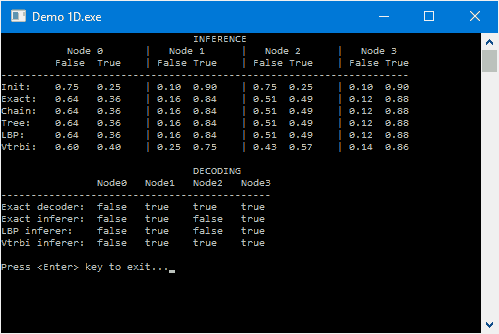 |
Direct Graphical Models
v.1.7.0
|
 |
Direct Graphical Models
v.1.7.0
|
In this demo, we use a very simple graphical model to represent a very simple probabilistic scenario, show how to input the model into DGM, and perform inference and decoding in the model. This example copies the idea from the Cheating Students Scenario
In order to run this demo, please execute "Demo 1D.exe" exact command
First of all we build a graph, consisting of 4 nodes, which represents 4 studens. We connect these nodes with undirected arcs. Since every student may give either true or false answer, every graph node will have 2 states:
Next we fill the potentials of nodes and arcs of the graph. We assume that four studens are sitting in a row, and even studens have 25% chance to answer right, whereas odd students have 90% chance. The edge potential describes that two neighbouring students are more likely to give the same answer. We fill the potentials by hand in the fillGraph() function:
We end up with the followiung graphical model:

The initial chances for students to give right ansvers, were given as if every student was alone. Now, when we have all four students sitting together (modelled with edge potentials), these chances are not independent anymore. We are interested in the most probable scenario, how answer these students, when they answer together. To solve this problem, we have to apply decoding or/and inference upon the given graph. Let us consider these processes separately.
The decoding task is to find the most likely configuration, i.e. the configuration with the highest joint probability.
For trivial graphs where it is feasible to enumerate all possible configurations, wich is equal to \(nStates^{nNodes}\), we can apply exact decoding - for other cases, approximate approaches should be used. Exact decoding is based on brute force estimation of the joint probabilities for every possible configuration of random variables, associated with the graph nodes. In DGM decoding returns the most likely configuration directly:
The inference task is to find the marginal probabilities of individual nodes taking individual states.
For our example, marginal probabilities describe the chance of every student to answer the question right. DGM inference procedures store the marginal probabilities in the node potentials vectors.
Each inference class has decode() function and could be used for approximate decoding. This function returns the configuration, which maximases the marginals, and this configuration in general is not the same as the configuration corresponding to the highest joint probability, i.e DirectGraphicalModels::CDecodeExact::decode() \(\neq\) DirectGraphicalModels::CInferExact::decode():
Finally, we depict the results of inference and decoding. In the INFERENCE table the initial node potentials, and marginal probabilities after inferece are shown (for our simple graph, we can also use exact chain and tree inference algorithms, approximate loopy belief propagation and viterbi algorithms). In the DECODING table the rsults of the exact decoding and approximate decodings from inferece are shown. Please note, that the correct configuration, provided by the exact decoder is {false, true, true, true}. However, the exact inference methods provide us with the configuration {false, true, false, true}, and only Viterbi (max-product message passing algorithm) gives correct decoding, build upon marginals from the table INFERENCE:
